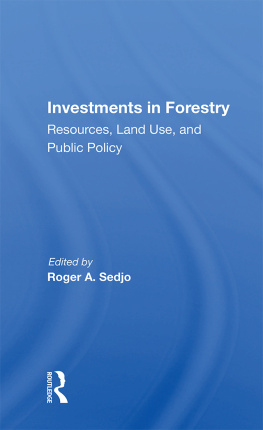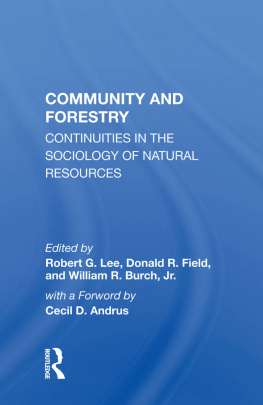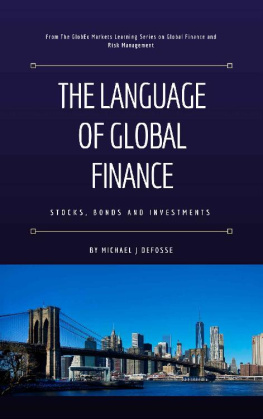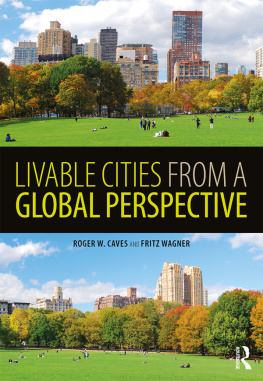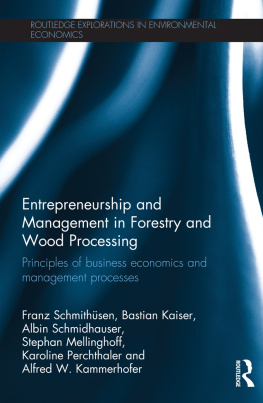Investments in Forestry
Westview Special Studies
The concept of Westview Special Studies is a response to the continuing crisis in academic and informational publishing. Library budgets for books have been severely curtailed. Ever larger portions of general library budgets are being diverted from the purchase of books and used for data banks, computers, micromedia, and other methods of information retrieval. Interlibrary loan structures further reduce the edition sizes required to satisfy the needs of the scholarly community. Economic pressures on university presses and the few private scholarly publishing companies have greatly limited the capacity of the industry to properly serve the academic and research communities. As a result, many manuscripts dealing with important subjects, often representing the highest level of scholarship, are no longer economically viable publishing projects--or, if accepted for publication, are typically subject to lead times ranging from one to three years.
Westview Special Studies are our practical solution to the problem. As always, the selection criteria include the importance of the subject, the work's contribution to scholarship, and its insight, originality of thought, and excellence of exposition. We accept manuscripts in camera-ready form, typed, set, or word processed according to specifications laid out in our comprehensive manual, which contains straightforward instructions and sample pages. The responsibility for editing and proofreading lies with the author or sponsoring institution, but our editorial staff is always available to answer questions and provide guidance.
The result is a book printed on acid-free paper and bound in sturdy, library-quality soft covers. We manufacture these books ourselves using equipment that does not require a lengthy make-ready process and that allows us to publish first editions of 300 to 1000 copies and to reprint even smaller quantities as needed. Thus, we can produce Special Studies quickly and can keep even very specialized books in print as long as there is a demand for them.
About the Book and Editor
Can forestry compete with manufacturing and agriculture for scarce capital or is investment in forestry attractive only when non-economic considerations--for example, the social desirability of forestry investments--are taken into account? Addressing this question, the contributors to this book assess the market for forestry products in the short- and long-term future; examine the competition between agriculture, cities, and forestry for use of land; identify strategies that private, industrial, and public investors might adopt; and look at the effects of government policies on private investors.
Roger A. Sedjo is senior fellow and director of the Forest Economics and Policy program at Resources for the Future and author of The Comparative Economics of Plantation Forestry: A Global Assessment (1983).
Investments in Forestry
Resources, Land Use, and Public Policy
edited by Roger A. Sedjo
First published 1985 by Westview Press, Inc.
Published 2018 by Routledge
52 Vanderbilt Avenue, New York, NY 10017
2 Park Square, Milton Park, Abingdon, Oxon OX14 4RN
Routledge is an imprint of the Taylor & Francis Group, an informa business
Copyright 1985 Taylor & Francis
All rights reserved. No part of this book may be reprinted or reproduced or utilised in any form or by any electronic, mechanical, or other means, now known or hereafter invented, including photocopying and recording, or in any information storage or retrieval system, without permission in writing from the publishers.
Notice:
Product or corporate names may be trademarks or registered trademarks, and are used only for identification and explanation without intent to infringe.
Library of Congress Cataloging in Publication Data
Main entry under title:
Investments in forestry.
Includes index.
1. Forests and forestry--Finance. 2. Forests and
forestry--Economic aspects. 3. Investments. 4. Forests
and forestry--United States--Finance. 5. Forests and
forestry--Economic aspects--United States. 6. Investments
--United States. 7. Forest policy--United States.
I. Sedjo, Roger A.
SD393.I58 1985 338.1'34'0973 84-22078
ISBN 13: 978-0-367-00830-7 (hbk)
Contents
, Jay M. Hughes
Roger A. Sedjo
, W. W. Rostow
, Charles W. Bingham
, Thomas R. Waggener
, Donald Miller and Robert Rose
, A. Alan Dyer and E.W. Frayer
, James G. Yoho
, Marion Clawson
, Dennis E. Teeguarden
Controversy has swirled around policy issues concerning U.S. forest land resources since the founding of the colonies. There is no controversy about the fact, of course, that timber as a source of wood products is an important resource in the American way of life. Approximately 5 percent of the nation's gross national product and employment rate is attributed to the wood product industry. Decisions made to invest in the growing, processing, and distribution of the products of this resource thus affect deeply the economic well-being of the nation.
Timber as an investment target Is especially interesting in light of two factors. One is the long time period required to create a new crop of timber from which to extract wood products. Another is the unique mixture of public and private ownership of forests and timber in the United States. The long time period required from planting to harvest (ranging from perhaps 20 to 120 years, depending upon product objectives and local growth rates) generates an uncommon amount of concern about the ability to predict prices and costs to a degree of precision adequate to support conventional investment decisionmaking. Public owners (or the public professional trustees for public forests) and private owners often have different criteria for investment in forests and timber, and the effects on these forests of applying these different criteria are also different. Further, the objectives of private users of public forests and timber tend to go unsatisfied, at least in the short term, because managerial and investment decisions of the public forest managers must be hedged with the objectives of other users of these same forests. It is, therefore, necessary to expect varying resource supply response nationwide to changes in investment incentives such as Interest rates.
Rationalizing this variability in investment objectives and response may be easier or more understandable as a result of the papers included in this monograph. These were presented at a national symposium on forestry investment opportunities held January 17 and 18, 1983, in Denver, Colorado. The symposium was cosponsored by Colorado State University and Resources for the Future with supplemental financial support from the Burlington Northern Foundation.
Jay M. Hughes
Dean, College of Forestry
and Natural Resources
Colorado State University
Numerous individuals and organizations cooperated in the symposium, "Investing in Forestry's Future," from which this volume is largely drawn. Keith Arnold played a critical role in bringing together the Forest Economies and Policy Program of Resources for the Future and the College of Forestry and Natural Resources of Colorado State University as joint sponsors of the symposium. In addition, Keith made a major input into the preparation of the symposium's program and through his direct participation in the symposium as a moderator. Also, both Resources for the Future and the College of Forestry and Natural Resources (CSU) deserve special thanks for their support of the symposium. Funding for the symposium was provided directly by the Burlington Northern Foundation and also by the U.S. Forest Service and the Weyerhaeuser Company Foundation through their support of the Forest Economics and Policy Program of RFF.


